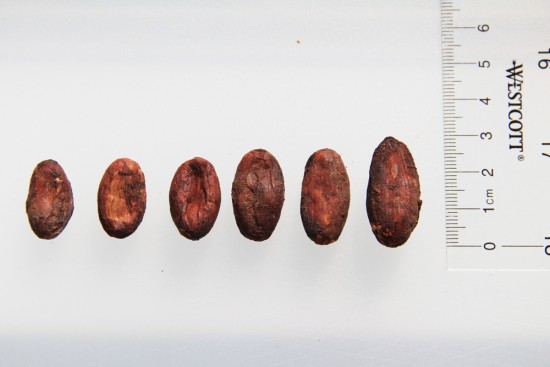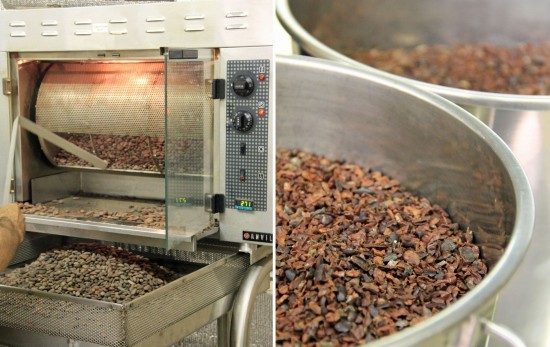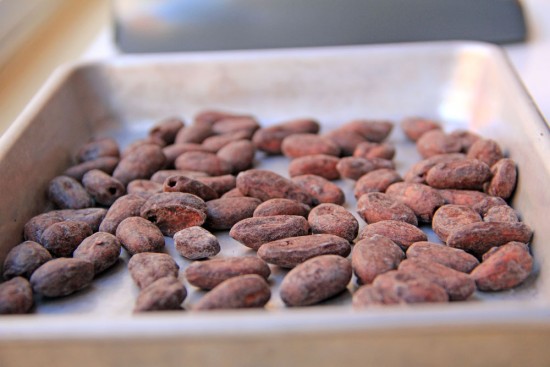Previously harvested, fermented and dried at origin, cocoa beans arrive at ICE’s Chocolate Lab ready to transform from raw bean to finished chocolate bar through cleaning, roasting, winnowing, milling, refining, conching and tempering.
There is no specific formula to determine optimum roasting time and temperature across the board: beans of different size, variety and origin require a unique roasting profile to achieve the desired end results. It is at this stage where the manufacturer begins to place an individual stamp on the finished product.
Before the beans are loaded into the roaster, they must be cleaned and sorted. While this involves sifting out dust and broken beans, we are also on the lookout for flat beans (essentially all shell and no nib), germinated beans (easy to spot by the perfectly round hole on the end of a bean) or any part of the pod that isn't a bean.
Anything other than a sound bean will do us no favors in the flavor of the finished product. Novice chocolatiers are often surprised by how much non-cacao debris is found: from sticks and stones to pieces of the burlap sack that the beans arrive in. In chocolate-making circles, one hears of all kinds of sorting table discoveries—some I chalk up to urban legend—but I'll just leave those possibilities to your imagination!

In general, the chocolate roasting process is similar to that of coffee, except coffee needs fast, high-temperature roasts, while cacao should be handled gently, with a lower and slower treatment. Typical cacao roasting temperatures range from 250-275°F up to 350°F, with the roasting process lasting between 30-90 minutes. Other variables—such as a cold or hot start and temperature adjustments during the process—are influenced by the inherent characteristics of the beans and the particular style of the manufacturer.
Many chocolatiers believe that Forastero-type beans are more amenable to a deep roast, while more subtly nuanced Criollo beans need a lighter roast. Regional differences can also influence roasting style. For example, a bean from Madagascar, known for its bright fruitiness, may need a longer roast to rid it of excess acidity, yet not such a deep roast that those desired fruity notes are driven off.
My first test batch of Madagascar beans was a nail-biter, I had to observe the roast carefully to find the perfect “sweet spot.” In the end, the roasted nibs had a complex flavor—not too acidic, but with an interesting hint of citrus and passion fruit that carried through to the finished bar!
Roasting equipment can vary—from massive, old school ball roasters to converted coffee roasters, to low-tech solutions such as roasting thin layers of beans on sheet pans in standard convection ovens. With large-scale manufacturing, producers may forgo whole beans and apply the roasting process to cracked and winnowed beans (nibs) or even to the milled liquor itself.
In ICE’s lab, we utilize a drum roaster—small by most standards—with a capacity of about 15K (35 pounds). No matter the method, the key to proper roasting is even transfer of heat and adequate airflow. During the roast, ICE’s lab and adjoining hallway are filled with an intense aroma similar to freshly baked brownies.
While we use some subjective measures like taste and smell, our drum roaster also allows us to determine the depth of roast by way of bean mass temperature: a thermocouple probe is buried within the tumbling mass of beans, giving us some degree of quantifiable flavor data. Although we may, for example, set the roaster to 300°F, I will often pull the beans once they’ve reached a mass temperature of anywhere between 245-275°F.
Even before that, I will sample beans for tasting, around an internal mass temperature of 235-240°F. It is fascinating to witness flavor transformation within a narrow difference of just five to 10 degrees.

So what is really happening during the roasting process? Heat treatment renders the beans safe to consume, destroying harmful bacteria and mycotoxins. I often tell students that raw cocoa beans should be treated like raw meat in terms of their bacterial risks.
Roasting also rids the beans of moisture and certain volatile acids: out of the bag, dried beans contain roughly 7% water, and it is common to lose four to five percent of the bean weight to water loss during roasting. Roasting will also loosen the shell of the bean, which helps facilitate the winnowing process later on. Most importantly, all of the complex chemical reactions (Maillard reactions and Strecker degradation) take place during roasting, transforming the flavor precursors created during fermentation into hundreds of individual compounds that give chocolate its alluring color and taste.
As with most foods—like a steak or a loaf of bread—the cooking process continues even after we've removed the beans from their heat source. Put simply, cocoa beans, if not quickly cooled, will continue to roast after leaving the roaster. When we reach our optimal profile (experienced roasters aim for the point just before this to allow for “carry over” cooking), the beans are dumped onto a cooling cart, where a vacuum draws air through the beans to expedite the cooling process.

Roasting is a crucial component to the flavor of chocolate and the first opportunity for the chocolate maker to infuse their individual approach. Assessing the beans and knowing which of their qualities to enhance is a skill gained from experience and intuition.
An important part of our work in the ICE Chocolate Lab is the documentation of every measurable part of the process. With every batch of beans, I plot out detailed roasting curves, logging bean and roaster temperatures every few minutes. Not only do these efforts help correlate temperature with flavor, but they are an important step towards the ability to produce multiple batches with some degree of consistency.
Eager to study in ICE’s Chocolate Lab? Click here for upcoming classes.




